THE FIRST FLEMISH CHEF AWARDED 3 MICHELIN STARS
text and photos ©
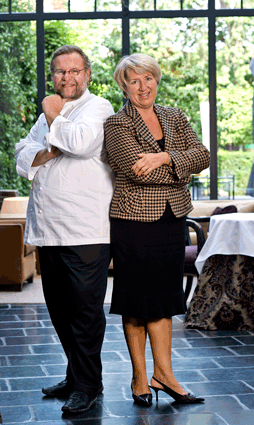
Chef Geert Van Hecke and his wife, Mireille De Demunck, who runs the front of the house
photo courtesy of De Karmeliet
Thanks to the New York office of the Flanders Tourist Board, last May Lucy Gordan, the Rome Bureau Chief of Epicurean-Traveler.com, visited Brussels, Bruges, Antwerp and Mechelen. In Bruges to cover the annual “Procession of the Holy Blood,” she interviewed Geert Van Hecke, the Flemish chef with 3 Michelin stars since 1996. Afterwards he invited her to dinner at his restaurant De Karmeliet. Her tasting menu: Amuses-bouche, blue lobster and cuttlefish, cauliflower and artichoke with shellfish oil, thin omelette with Oriental spices, and glazed tomato; white asparagus and fresh morel mushrooms, salmon with a crust of wild mushrooms; young duck from Dombes à l’Orange, the glazed leg and stuffed neck, garden peas the French way; chocolate dessert with passion fruit, oranges, and chocolate ice cream, and sweets with fruits and chocolates. The wines were: Dr. Bürklin-Wolf, 2009, Wachenheimer, Riesling, from the Pfalz in Germany; Les Chemins de Bassac,Vin de pays des Côtes de Thongue, La Ginestet 2008, France; Glatzer, Carnuntum Austria, Zweigelt 2009; and Tokaj aszù 3 puttonyos 2007 from Hungary.
Our tastes in food are closely connected to our childhood; what are your first memories of food?
GVH: Pastries and bread. My grandfather Georges Van Coillee, my mother’s father was a baker and pastry chef. He had a bakery in a very small town called Egen; it had been his father’s. My grandfather had six daughters, and a son destined to take over the business, but died at age 25. My grandfather died in 1968, and so ended the bakery.
My parents had nothing to do with food professionally. My mother was a housewife. She was a very good cook so I also remember her wonderful home cooking, seasonal dishes. In Belgium we eat what is in season, in the garden: particularly potatoes, asparagus and chicory. My mother made two especially delicious dishes: local ham with melted cheese and a béchamel sauce, and sausages with red cabbage or cauliflower. Everyday my mother made cakes, waffles, and pancakes. We also ate a lot of fish. We were three children; I’m the middle one. My father made wooden furniture. He often went to Ostend so brought home fish, especially cod, sole, and eels.
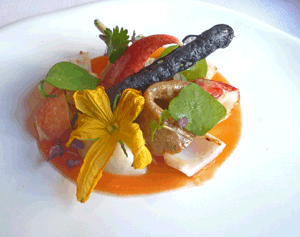
Blue lobster and cuttlefish, cauliflower and artichoke with shellfish oil, thin omelette with Oriental spices, and glazed tomato
Why did you decide to become a chef?GVH: I decided when I was ten. At 12 I should have gone to cooking and hotel school, but my parents didn’t approve; they wanted me to learn Latin and Greek, but I lasted only two years. Then I studied modern languages for another two years. Finally at 17 for the next three years I studied cooking at “Ter Diunen” in Koksijde; it’s still the most famous hotel school in Belgium.
Who were your mentors and what did you learn from them?
GVH: I didn’t have any mentors from school, but I loved it there. I lived there during the week and would go home, 25 miles away, on Saturday and Sunday. I worked in a small restaurant near my home in the small town of Pittem not far from Egen on weekends; it doesn’t exist anymore.
Even when you graduate from cooking school, you don’t know very much. My first real job for 8 months, an internship for school, was in the Ardennes here in Belgium. It was at “Le Sanglier des Ardennes” near Durbuy. I was asked to stay a bit longer. My second job was at the “Villa Lorraine” in Brussels, the first restaurant not in France to have three Michelin stars. It doesn’t exist anymore either. It got its third star in 1972; I worked there from 1977-1978. It served a classic French kitchen. I learned a lot, all the basics, cooking according to the season, fresh products, and the best things you can eat, from the head chef, Freddy Vandecasserie. My third job was with Alain Chapel, one of the originators of Nouvelle Cuisine, whose namesake restaurant in Mionnay near Lyons also had three Michelin stars. He was my mentor. He was also Alain Ducasse’s mentor. Alain and I worked together there for two years, 1979 and 1980. Alain’s my age. He’s a big shot now; I’m still small. Nonetheless we are friends. From Chapel I learned culinary philosophy, how to run a top kitchen. He used only local and top products. His specialties were innards. The cuisine from the region of Lyons specializes in innards.

White asparagus, fresh morel mushrooms and salmon
What are the essential qualities of a top chef?
GVH: Courage.
What do you like best about your work?
GVH: The creativity and freedom to do what I like.
The least?
GVH: I think there are things that you don’t mind when you are 30 but do when you are older. For me, it’s the paperwork: payroll, taxes, accounts, and bills. Every day I receive at least 30 different types of papers. I don’t like dealing with personnel problems either. I also don’t like arriving at the restaurant and finding out that a kitchen appliance doesn’t work. Every day there’s some kind of problem. I’m 56 and I don’t like solving problems any more.
What’s your culinary philosophy?
GVH: To use only seasonal products and of those the freshest available.
In a nutshell, how would you define your cuisine?
GVH: Fresh seasonal cuisine using local products and some products from France because it’s not far from here, for example, fish from Brittany. I emphasize taste, true flavors, so asparagus tastes like asparagus, wild mushrooms like wild mushrooms.
What are your signature dish and other specialties?
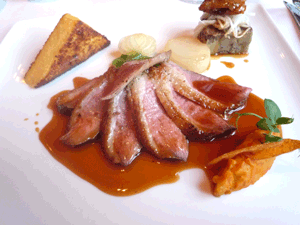
Young duck from Dombes à l’Orange
GVH: Every season has its specialty: for example, now in spring we feature asparagus and
strawberries from here as well as wild mushrooms from the Ardennes and from France, local lobster, salmon, turbot, codfish, eel in green sauce which is a typically Flemish dish, and baby lamb from France. In the summer we have grey shrimp from Belgium, which are at their best in August, in winter fresh truffles, chicory, and local ham.
What are the reasons for your success?
GVH: The fact that I stay in my kitchen. I arrive here at 8:15 in the morning and I go home at midnight or 1 AM. I don’t appear on television. I would never have a TV program. I work very hard. In addition to De Karmeliet, I opened a brasserie next door in 2009. Tonight it will host more than 100 guests. Here at De Karmeliet we run an expensive restaurant. Tonight we have 24 bookings. At the brasserie, which is run by my son, dinner costs less; it also features dishes from Flanders. My life is kitchen, kitchen, kitchen. I concentrate on preparing the best food possible in the best possible ways. For 25 years my wife, Mireille De Demunck, has been in charge of all our cheese: from Belgium, France, Italy, and sometimes Denmark.
So you’ve always worked in Belgium?
GVH: I worked a year in Paris too and, as I said before, two years and a half in Mionnay near Lyons with Alain Chapel. After that I worked a year in Brussels before coming to Bruges. I’ve had my own restaurant since 1983. The first one was small, 500 yards from here; it had the same name as this one because it was near a former Carmelite convent. We were only five people: one with me in the kitchen, one with my wife in the dining room and one to clean. After a year we had one Michelin star. Then four years later we had two stars. In 1992 we moved to this location and in 1996 we received our third star. I was the first chef in Flanders to have three Michelin stars. Now we are three. One is Peter Goossens, whose restaurant “Hof Van Cleve” is in Kruishoutem; the other, who earned his third star this year, is Gert De Mangeleer whose restaurant “Hertog Jan” is in Sint Michiels just outside Bruges. De Mangeleer is only 33 years old and thus one of the youngest chefs to have earned a third Michelin star. His partner Joachim Boudens, who was named the “Best Sommelier” in Belgium in 2005 and again in 2011, worked here.
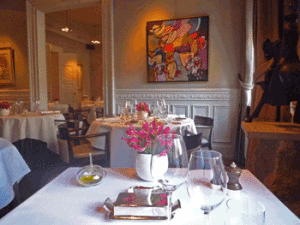
So you are not like Ducasse with restaurants all over the world?
In Belgium it’s not possible to be a chef of the world. In France it’s possible to find sponsors and investors who will spend money for your expansion.
Up to now you’ve told me about Geert Van Hecke the chef; I’d like to know more about Geert Van Hecke the person. For example, what are your favorite foods?
GVH: I like lots of seasonal local dishes. When I go to London I like Indian and Thai cuisine. I like Japanese too, but it can be monotonous, with only a limited number of dishes.
If you were in jail, on Death Row, what would you order as your last meal?
GVH: Steak Tartare.
A dish you dislike?
GVH: Liquorice.
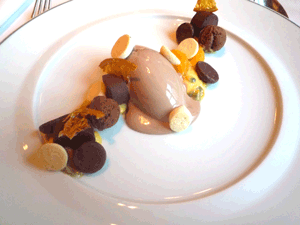
Chocolate ice cream with passion fruit, oranges, and sweets of fruit and chocolate
Your favorite wines?
GVH: White Burgundies and the wines from the Côte de Rhône.
A favorite dessert?
GVH: That’s more of a problem because I’m not allowed to eat a lot of sugar. Vanilla ice cream I guess.
Your favorite color, flower?
GVH: I don’t have a favorite flower. I like green, and red and black clothes, but not all black. I like color contrasts.
Chefs are well known for having collections, often of motorcycles, fast cars, or watches; what about you?
GVH: I have an art collection. Here in the restaurant the paintings are more classical, but in my house they are modern from the 1930s to the 1980s. I don’t have one favorite artist, but I try to collect Belgian art: the CoBrA School which stands for Copenhagen, Brussels, and Amsterdam, Appel, Alechinsky, Willem Van Hecke (I have 30 of his paintings. He has my same surname, but is not my relative), Dotremont, and Spilliaert.
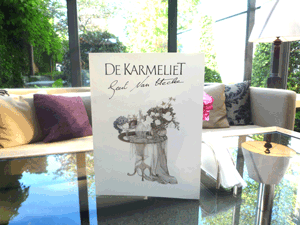
De Karmeleit menu
Where do you like to go on vacation?
GVH: France and Spain. I have a house in France. I once booked to go to New York, but then 9/11 happened and we had to cancel. I wanted to see the wonderful museums there. Wherever we go, we visit the museums, but we have never been farther than the south of Spain and southern Italy. We’ve seen a lot of Italy, but it was 15 and 20 years ago. Now because we have a house in Provence we go there.
Other chefs you admire?
GVH: I don’t like to list names, especially of my Belgian colleagues. Instead of friends, you make enemies if you forget someone by accident.
What about non-Belgians?
GVH: In France among others Alain Ducasse, Michel Bras, Troisgros, Guy Savoy, Eric Frechon at the Hotel Bristol in Paris, Jacques and Régis Marcon at the “Aubèrge et Clos des Cimes” in Saint Bonnet le Froid; and in Italy Alfonso Iaccarino at Sant’Agata sui Due Golfi, and Annie Féolde at the “Enoteca Pinchiorri” in Florence. In Germany I like the restaurant “Schwarzwaldstube” in the Black Forest and in London the restaurant “Gavroche.” In the US I don’t know because I’ve never been there.
If they hadn’t become chefs, Heinz Beck told me he had wanted to be a painter, Marchesi a pianist; Emanuele Scarello the Center Forward of the best soccer team in the top league (serie A). What about you?
GVH: Oh God, I think an architect. Definitely, something creative.
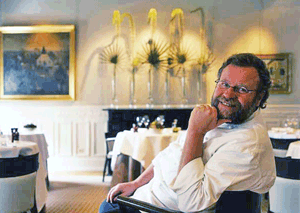
& & &
Lucy Gordan is an award-winnning travel writer and cultural journalist living in Rome, where she is Epicurean-Traveler.com’s Bureau Chief. She can be reached at gordan@attglobal.net. Her website is www.lucygordan.com.
